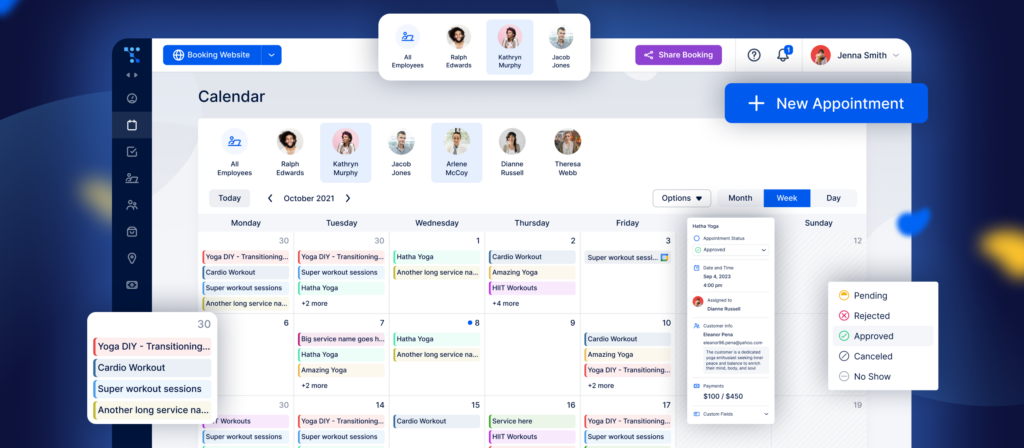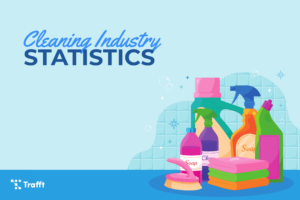When starting a house cleaning business, setting the right prices is crucial.
In order to determine how much to charge for house cleaning, there are several things you need to consider.
Every cleaning company is different, and their price-setting methods will vary. How to find out what the best price range for your business is? Looking solely at your competitors and using their prices as a reference could be harmful. If your prices don’t accurately reflect your market, labor, or the value of your offerings, you risk underselling your work.
This article will help you decide how much to charge for house cleaning services and how to determine your house cleaning prices.
Details to Consider When Deciding How Much to Charge for House Cleaning
Before you establish exact numbers, think about the most common factors that will influence your house cleaning costs.
Understanding local market rates for house cleaning
First, consider the typical rates and how much do house cleaners charge in your region. Compare them to the national average. This is your starting point. It’s important to start by researching the house cleaning costs in your area, and use this information to form your prices.
Your local area will play a large part in answering the question of how to price house cleaning jobs. In large metropolitan areas, house cleaning businesses may charge a premium rate compared to rural areas or small towns. Remember, large cities aren’t a monolith. They have a mix of income levels to consider. In a lower-income area, high house cleaning costs won’t gain you many clients, if any.
Lower rates in a high-income area, however, could leave you making far less than what’s possible. Do the research and make sure your rates match what your target clients will pay.
Identifying your ideal client for targeted house cleaning services
Don’t overlook your own work style and the type of client that suits you best.
When you picture your ideal client, what do you imagine? Would you rather help older clients with keeping their homes tidy? Would allergies send you running from a house that has pets? Do you mind a busy family with lots of cleaning, or would you prefer a quiet working environment?
If you know your ideal client, you can easily figure out how to advertise your cleaning business.
These factors will determine both your prices and where you market your services. Make sure you don’t overlook them when setting your rates.
Leveraging experience to justify your house cleaning prices
As with any job, the more experience you have, the more money you can demand. If you are new to the cleaning industry, your house cleaning rates should not exceed those of experienced cleaners.
Once you’ve gained experience and built up a portfolio of happy clients, those references allow you to demand premium house cleaning prices. This balance is key to running a successful cleaning business.
Calculating labor costs
If you work alone, your price structure will be fairly straightforward. If you have a cleaning crew, work out how you’ll pay these employees.
Generally, your cleaners will get paid by the hour. Add around 18% for payroll after multiplying your hourly rate by the number of cleaners and staff involved in the job.
Calculating overhead costs and other expenses
You can expect your business to incur costs that aren’t solely based on your cleaning materials or time worked. Besides cleaning supplies, your marketing costs, budgeting and payment software, transportation costs, and other items will add up quickly, and all contribute to the overall house cleaning costs. These are called overhead, and your prices should cover these expenditures.
Budget carefully so you don’t end up running your business on a deficit. Overhead, labor, and location aren’t the only considerations for your cleaning business. What else should you add to your list?
Assessing home condition for customized cleaning rates
How dirty is the client’s home?
A new client may have a lot of cleaning needs, and you’ll need to perform a full house cleaning on your first visit. The frequency will alter your prices because of how much time is required to clean the home.
Subsequent cleanings will call for lower prices, but you’ll save time and effort in those sessions. They will go smoothly for you, and you’ll still have the energy for other jobs.
Creating pricing strategies based on cleaning type
The type of cleaning you offer will affect your rates. The complexity of the services you offer will determine whether you should charge higher or lower fees. Consider creating packages for special house cleaning services.
Move-out cleaning costs
Move-out cleaning services are for those who are moving homes, or landlords that rent houses.
This service may include deep cleaning of all areas and rooms. Depending if the house is furnished or not, you should form your prices accordingly. The average move-out cleaning costs range from $40 to 100/hour per cleaner, or $0.13 – 0.20 per square foot.
Post-event cleaning costs
This service is for clients that hosted an event or a party in their home, and need you to help with the cleanup. Average prices for post-event cleanings are $25 – 90/hour per cleaner, or $0.12 – 0.80 per square foot. The process involves restoring the place to pre-even condition – cleaning up spills, floor cleaning, and removing trash.
Standard cleaning costs
Vacuuming, mopping, wiping down surfaces, and dusting in all rooms of the house are all considered standard cleaning. Standard house cleaning rates are $20 – 50/hour per cleaner, or $0.07 – 0.16 per square foot.
Deep cleaning prices
Deep cleaning requires detailed and thorough cleaning and is best for homes that haven’t been cleaned professionally in a while. This service goes beyond the standard sweep, involving tasks such as scrubbing floors, washing walls, cleaning behind appliances, and other areas often overlooked in regular cleaning routines. This approach is often called full house cleaning, which ensures that every nook and cranny receives attention.
You should add 30 – 50% to your standard rates. The cost to deep clean a house is $40 – 100/hour per cleaner, or $0.13 – 0.17 per square foot.
Extra services and their prices
Clients may ask for extra services from time to time. Make sure you outline which provisions are standard and which services are add-ons.
Some services that might warrant additional fees include:
- Cleaning large appliances (like the refrigerator or oven) – $25 – 35+
- Doing laundry – $5 – 20 per load
- Changing linens – $10 per bed
- Floor stripping and waxing – $0.30 – 0.50 per square foot
- Cabinet cleaning – $25 – $45+
- Carpet cleaning – $0.16 – 0.28 per square foot
- Cleaning inside and/or outside windows – $2 – 6 per window
- Baseboard cleaning – $35+
Researching the market to optimize house cleaning prices
The cleaning industry is very competitive.
Without careful research, you could place yourself at a disadvantage. You want to stand out to potential clients, but you can’t do this if you don’t know your market. This goes beyond scoping out prices. You’ll want to find out other companies’ strengths and weaknesses. This way, you’ll position yourself ahead of your competition.
There are two kinds of market research, primary research and secondary research. Primary research involves compiling your own original data. Secondary market research involves using publicly available data to gain insights.
This may sound difficult, but if you already did the work to set your prices, you’re halfway through your research.
Here are a few tips to get started:
- Start online with a quick search to find companies in your area that are providing home cleaning services.
- Check companies’ websites to see what services they offer and how they present themselves.
- Check sites like Yelp or Home Advisor for company listings.
- Look for companies’ social media accounts like Facebook, Instagram, and LinkedIn.
This market research will give you ideas to set yourself apart from other businesses. It is a powerful tool for creating your business strategy.
Analyzing competitors to stay ahead in house cleaning rates
Now you’ll look more closely at your competition. You need to know what their house cleaning prices are, what services they provide, and how long they have been working in your chosen area. Do they market to specific clients? Do they have a good reputation? How do they advertise their services?
Knowing the average house cleaning costs for your area will give you a clearer idea of what you should charge for your own home cleaning services. This way, you will stay competitive and profitable in a highly demanding industry.
You won’t need an elaborate scheme to find what your competitors charge. Call them and ask directly or check their website and social media accounts. You could also ask for a quote for cleaning your own home. Collect the house cleaning rates of several companies to get a good list of their prices.
Once you’ve established those rates, find their average. You do this by adding all their prices together and dividing by the number of rates.
If you know the rates of three competitors, add each of them together and divide by three to find the average.
(Company A price + Company B price + Company C price) ÷ 3 = Average price
Now you can calculate how much to charge for house cleaning!
Considering eco-friendly products
Clients and businesses alike are turning to eco-friendly practices to reduce harmful effects on both the environment and human health. Some cleaning products cause skin and breathing problems. If you plan to use environmentally friendly products, you will protect yourself and your clients.
Going green costs more, and you’ll spend more money on your equipment and supplies. Add these increased costs to your rates. You can appeal to a higher-paying clientele by advertising your high-end, eco-conscious services.
Setting a Final Price
Choose a pricing method
There are several methods to determine how to price residential cleaning jobs.
Depending on your clients, how many customers you can serve each day, or other personal factors, each method will have pros and cons. Review the pricing styles below to find the best fit for your company.
1. Per hour
Before setting your price, you should check out some interesting house cleaning statistics.
The United States average hourly wage for a maid, cleaner, or housekeeper is $13.84. This number is slightly higher or lower, depending on the employee’s skill level, state wage average, and whether they work in private homes or hotels. Private homes usually pay better rates. You may use the average pay per state as a starting point for pay but don’t forget to adjust the rate for experience and the work involved. You want to receive a fair wage.
The hourly cleaning rate you set for cleaning a house should account for labor, overhead, and profit margins. An hourly rate of $25–50 is appropriate for less experienced cleaners or standard services. A one-time deep cleaning could cost up to $100 per hour.
If you want to remain competitive in the industry, plan to fix your rates between $40 and $65 per hour. Some factors might cause these numbers to fluctuate.
Charging an hourly rate is ideal if you’re first starting your cleaning business. In the beginning, it will be harder to estimate how long a job will take, and an hourly rate allows you to use all the time you need.
2. Flat fee
A single-family home will cost from $117 to $235 to clean, based on numbers from Home Advisor. The national average is currently $170.
This price depends on the client’s home size, condition, and how often you’ll clean. Perhaps you could discount weekly cleaning but charge regular rates for monthly and bimonthly cleanings.
Flat fee pricing will remove concerns about fair payments for your services. This pricing method is very common and successful for house cleaners.
The flat fee method is based on the value you provide for clients, not the time a job takes. Your services solve a problem for them. How much are clients willing to pay for that solution?
What if your client lives alone and works long hours? Cleaning their home and doing laundry after a long workday is a big drain for them. Your services bring them value. It allows them to work without worrying about spending what’s left of their time and energy on housework.
Your flat fee should account for factors like time, the number of rooms, and the number of cleaners assigned to a job. Add enough to the cost to cover unexpected expenses like vehicle gas or replacing damaged equipment. Remember, you want your business to earn a profit.
A flat fee also works well for standard cleaning and one-time jobs, like moving or post-event cleaning.
3. The square footage method
For weekly and biweekly jobs, home cleaning businesses in the U.S. charge an average of $0.07 to $0.20 per square foot, according to HomeAdvisor. Cleaning rates generally max out at $0.20 per square foot for extensive cleaning jobs. These deep cleanings involve cleaning up after hoarders or cleaning a home after someone has moved out.
A one-time deep cleaning may cost as much as $0.35 per square foot if the cleaning job is extremely laborious.
For example, a 2,000-square-foot home could cost $140 per week for each cleaning. This price rounds out to $0.07 per square foot. You could charge a client $210 for deep cleaning their 700-square-foot apartment at a rate of $0.30 per square foot.
Estimating the job based on square footage creates the most appropriate rate, especially for large houses. Successful cleaning businesses price their services based on square footage.
When potential clients ask for a quote, you can give a basic number based on the size of their home. After visiting the property, checking its condition, and determining the actual work it requires, you can adjust the rates.
4. Room rate
Another standard pricing protocol uses the number of bedrooms in a home as the price baseline. This model is useful in a big city where apartments are common. Multi-bedroom homes would increase your overall price.
- 1-bedroom price: $75–130
- 2-bedroom price: $100–180
- 3-bedroom price: $130–220
- 4-bedroom price: $200–230
Some companies offer cleaning services for individual rooms. These cost between $30 and $80 per room.
This pricing strategy works well for weekly cleaning jobs when rooms are in good condition. Be sure to price types of rooms (like kitchen vs bedroom) accurately to make your desired profit.
A quick tip: Use a scheduling app to organize your bookings
Keeping your house cleaning business well-organized has never been easier.
Automate the process of scheduling and managing your appointments, notifying your customers, and keeping track of your employees with Trafft.
Trafft is a powerful booking solution designed to do labor-intensive work for you. It lets you schedule, reschedule, and track online bookings effortlessly, all while providing your clients with a smooth booking experience. Also, it enables you to manage your employees, track KPIs, and handle payments with ease.
Save hundreds of hours, increase your productivity, drive revenue by 30%, and grow your cleaning business with Trafft.
Want to know how Trafft can help you cut costs and save time?
Book a demo and find out.
What Do You Need to Charge to Make a Profit?
When deciding how much to charge for house cleaning, make sure you don’t undersell yourself and your work. Earning the bare minimum to cover your bills isn’t enough. Consider how you will earn a profit and grow your business in the future.
When creating a professional cleaning invoice template, ensure it clearly itemizes your services, includes your business contact information, and reflects the quality and professionalism of your cleaning business, making it easier for clients to understand and pay promptly.
The following example will give you a good idea of how you should calculate your house cleaning prices.
If the house measures 1,000 square feet, and it takes 1.5 hours to clean everything, how much should you charge for this house cleaning?
Start with an estimate of your hourly rate. If you are charging $30.00 an hour, multiply the time allotted for cleaning the house by your rate.
$30.00 x 1.5= $45.00
If you have cleaning staff, you must consider payroll taxes. This tax is officially called FICA taxes in the U.S. These taxes will cost about 18% of the cost of labor.
$45.00 x .18= $8.10
$45.00 + $8.10 = $53.10
Now your rate has risen to $53.10. Don’t forget to add the cost of your equipment. For this example, let’s assume supplies will account for 6% of your business costs.
$53.10 x .06= $3.19
$53.10 + $3.19 = $56.29
You haven’t finished yet. You need to include your overhead costs. These are costs incurred by your business and employees, like vehicle mileage, gas, website management, business software, and marketing expenses (like creating attractive business cards to hand out to your clients). Estimate these costs and determine how they will play into your final rates.
Conclusion on How Much to Charge for House Cleaning
Running your own business means you’ll have to figure out the best house cleaning prices on your own. It’s tough, but not an impossible task. Remember to account for time, labor, location, and profit margins. Your experience matters and so does the effort you put into each job.
Don’t undersell or oversell yourself!
If you don’t know how much to charge for a complicated cleaning job, propose an initial cleaning to get an idea of how much work it takes to clean the home before signing the contract.
This will prevent getting locked into a low rate for a considerable time. If you’re confident in your rates, don’t hesitate to sign a long-term contract with your client.
Starting your own cleaning business takes bravery and is applaudable. Hopefully, this article will help guide you in deciding how much to charge for house cleaning services so you can be successful!
FAQ
How much does house cleaning cost?
When setting your house cleaning prices, consider local market rates, the condition of the client’s home, and your cleaning experience. Prices vary, but generally, average cost of house cleaning is $20 to $50 per hour for standard cleaning. For more detailed pricing, consider using methods like charging per room, per square foot, or a flat fee based on the home’s size and the cleaning frequency needed.
How much does a cleaning lady cost per hour?
The hourly rate for a cleaning lady typically ranges from $20 to $50 for regular cleaning tasks. For deeper and more time-consuming cleaning, such as scrubbing floors or washing windows, the rate can go up to $40 to $100 per hour.
What does it cost to deep clean a house?
Deep cleaning a house is more thorough than regular cleaning and can cost about $40 to $100 per hour, or $0.13 to $0.17 per square foot. Deep cleaning involves extra tasks like cleaning behind appliances and scrubbing floors, which usually adds about 30% to 50% more to the standard cleaning rate.
How do you figure out the price for deep cleaning a house?
To price deep cleaning, look at the size of the house and how dirty it is. You might charge by the hour, usually $40 to $100, or by square footage, which could be $0.13 to $0.17 per square foot. Consider increasing your normal rate by 30% to 50% for the additional work involved in a deep clean.
Looking for More Cleaning Business Resources?
For more tips and tricks on how to start, manage, and grow your cleaning business, check out the following articles:
- How to Start a Home Cleaning Business
- Cleaning Industry Statistics in 2024
- How to Get Clients for Your Cleaning Business
- How Profitable Is a Cleaning Business?
- The Most Interesting House Cleaning Statistics You Must Know
- Grow Your Cleaning Business




